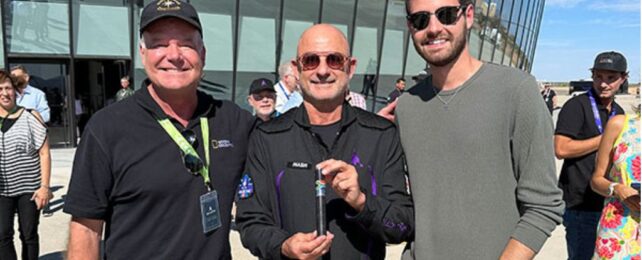A recent mission from the American spaceflight company, Virgin Galactic, is facing public backlash after it carried the remains of two extinct hominins into space.
The University of the Witwatersrand in Johannesburg, South Africa, is custodian of the fossils and its researchers are celebrating the event as a "historic first" and "a tribute to science and discovery".
Many experts online, however, have condemned the trip as a reckless and disrespectful publicity stunt with no scientific value.
On 8 September 2023, the South African-born billionaire Timothy Nash casually tucked a carbon fiber vial into the pocket of his cargo pants before boarding Virgin Galactic's rocket-powered craft, VSS Unity, bound for suborbital space.
Inside the container was a 2-million-year-old collarbone, from a hominin known as Australopithecus sediba, and a 300,000-year-old thumb bone from the hominin, Homo naledi.
They were about to go where none of their kind had gone before.
Two important ancient human relatives packed and ready to go where no extinct hominins have gone before! #neverstopexploring! pic.twitter.com/rngRVQipef
— Lee R Berger (@LeeRberger) September 1, 2023
"These fossils represent individuals who lived and died hundreds of thousands of years ago, yet were individuals who likely gazed up at the stars in wonder, much as we do," says Matthew Berger, who discovered the remains of A. sebida, and who handed the bones to Nash in a ceremony before the flight.
"I imagine they never could have dreamed while alive of taking such an incredible journey as ambassadors of all of humankind's ancestors."
But some scientists see that point as the very problem.
The connection between the human remains and space, they say, is tenuous at best, and while Nash might think that "human advancement requires risks" as he told National Geographic before the mission, scientists find it hard to see how this particular risk serves either paleontology or space travel.
"I am horrified that they were granted a permit," Sonia Zakrzewski, a bioarchaeologist at the University of Southampton, wrote on X. "This is NOT science."
"Is this a joke," chimed in archaeologist Danika Parikh from the University of Cambridge, "or are ancient human remains from South Africa really being taken to space? And not for any kind of research purpose, but for funsies and publicity?"
Joining the conversation on X, Natalie Kendrick, an Archaeologist Heritage Officer at Heritage Western Cape, explains that the only reason these remains were allowed to go to space is because they were not deemed 'human' but paleontological.
This means that the code of ethics that requires human remains to be treated with dignity doesn't apply to these bones, even though A. sebida is a potential human ancestor and archaeologists at Wits University argue rather contentiously that H. naledi buried their loved ones.
What not to do with hominin fossils, artefacts or samples. https://t.co/bEFIhRrYQV
— Dr Matt Pope (@MatthewPope) September 12, 2023
"The irony of a Netflix special where the team promotes just how 'human' Naledi behavior, and thus fossils, are, but a few months later in an official permit for space travel are happy to see these specimens as paleontological and decidedly not human for legal reasons," archaeologist Flint Dibble from Cardiff University pointed out on X.
Zeblon Vilakazi, the vice chancellor of Wits University, says that the fossils were carefully chosen for space travel because they "are among the most documented fossils of hominins in existence, with casts, scans and images available across the world due to our scientific and open access efforts."
But it's also true that modern technological advances allow researchers to look at fossils in new ways, which means even the most well-studied remains might still be holding untold secrets.
Thankfully, the fossils made it home safely, but Rachel King, an archaeologist at University College London, told Live Science in an email, that the fact they were approved for space travel in the first place "should make everyone think about potential wider consequences."
South Africa is home to some of the most precious ancient human remains ever discovered, and the thought of other bones being blasted into space or treated in a similarly risky fashion has some scientists concerned.
When it comes to the ethics of handling ancient human remains, researchers say there remain many legal gaps.
The way that researchers at Wits University have decided to care for these fossils is extremely contentious but it's not illegal.
The 'finders keepers' nature of the field means that those who discover the fossils, whether an individual, an institution or a government, can ultimately decide what happens to them.
